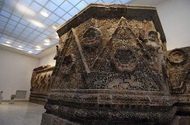The Berlin Museum for Islamic Art will be doubled in size in coming years to become one of the biggest exhibitions of its kind in the western world in a move its director hopes will help counter growing misperceptions of Islam.
Stefan Weber, who has headed the museum since February 2009, said it would be enlarged to more than 3,000 square metres and the layout made easier to understand, both for Muslim immigrants and non-Muslims.
“We want it to be a cultural and symbolic home for the four million Muslims living in Germany, many of whom have relatively little awareness of their cultural heritage,” Mr Weber said. “We would like to help convey to them that this is something they can be proud of, and that there’s a place in Germany that takes care of their legacy.”
The museum was opened in 1904 and is located inside Berlin’s world-famous Pergamon Museum. It contains art by Islamic peoples dating from the eighth to the 19th centuries and spanning an area stretching from Spain to India.
The main attraction is the giant facade of the eighth-century Mshatta Palace, which was excavated in 1840 in what is now Jordan and presented to Emperor Wilhelm II by the Ottoman Sultan Abdul Hamid II. Another highlight is a carved wooden ceiling from the Alhambra, dated around 1320, as well as 13th-century mihrabs and a collection of carpets and writings.
The carved wooden ceiling from the Alhambra, dated around 1320, is another popular exhibit at the museum.
The museum also boasts the Aleppo Room, a complete wooden wall from a merchant’s house in the Syrian city of Aleppo from around 1600, decorated in Arabic and Persian verses.
Mr Weber said he plans to ditch the museum’s current division into Muslim dynasties, which tends to confuse western visitors, and will focus instead on a simple geographical and chronological layout. The artefacts will also be allocated to individual areas of historical Muslim life – the palace, sacred rooms, the garden and the home, and there will be a focus on highlighting the ancient roots of Islamic culture.
“There’s an oversimplified view of Islamic culture and we want to show how diverse and rich it is,” said Mr Weber.
He said it was particularly important to counter politically distorted perceptions of Muslims now, in light of mounting Islamophobia in Europe that was highlighted by Switzerland’s vote to ban minarets last year. “It’s hard to say how much impact we can have, but we get more than 500,000 visitors a year and we can help to tackle prejudices.”
Global reassessing of Islamic art collections
The reorganisation is in line with a global trend. Museums in Copenhagen, Athens, London, Cairo and Toronto have or are in the process of reassessing and restructuring their Islamic art collections. The world’s biggest collection of its kind was unveiled in late 2008 with the opening of the spectacular Museum of Islamic Art in the Qatari capital of Doha, designed by the architect IM Pei.
Mr Weber said he disagreed with the recent decision by the Metropolitan Museum in New York to remove several images of the Prophet Mohammed after several conservative Muslims had protested against them. Many Muslims believe the depiction of the Prophet to be impermissible.
The enlarged Berlin Museum for Islamic Art will have room to display twice as many objects as now, many of which will come from its own vaults containing 50,000 exhibits. But it has also secured one of the world’s most important private collections, the Keir Collection, comprising calligraphy, ceramics, books and metalwork from Central Asia, Iran, Iraq, Syria, Egypt and Turkey. Under an agreement signed last year, some 1,500 objects amassed by the Hungarian-born British collector Edmund de Unger will move to Berlin for an initial period of 15 years.
The museum’s expansion, part of a ?351 million refurbishment of the Pergamon Museum funded by the federal government, is due to be completed in 2019.
Related Links:
London Shows Islam Science Contributions



